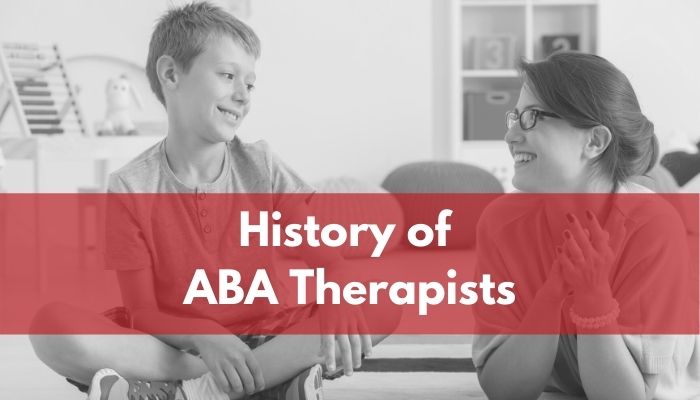
By Tania Duarte, M.S., BCBA
The history of the Applied Behavior Analysis (ABA) field is full of continuous development and improvements. Applied Behavior Analysis is a data-driven, evidence-based treatment for individuals with autism that helps with communication, socialization, and reduction of maladaptive behaviors. In honor of Autism Awareness month, let’s explore the history of the practice of ABA and how it has changed over time.
ABA’s Roots
It all began in the 1970s when B.F. Skinner, known as the father of Behavior Analysis, started applying his research in operant conditioning (a reinforcement learning method) outside of his lab and with real patients. Following this, in 1987, Ivar Lovaas applied those same principles to assist individuals with autism. In the 1990s, ABA started becoming recognized as an effective treatment for autism. However, at that time, there wasn’t a way to ensure individuals practicing ABA had the proper training and credentials in order to practice.
The Beginning of the Behavior Analyst Certification Board (BACB)

Due to these concerns, in 1998, the Behavior Analyst Certification Board (BACB) developed the Board Certified Behavior Analyst (BCBA) and the Board Certified Assistant Behavior Analyst (BCaBA) certifications with the goal of easy identification of qualified ABA practitioners. The BCBA certification is for those who supervise ABA sessions, create treatment plans and develop behavior reduction protocols.
The BCaBA certification was created for those who provide similar behavior analytic services but with the guidance and direction of a supervising BCBA. To obtain these certifications, you are required to complete a specified course sequence, obtain hours of practice and supervision in the field and pass a board examination.
One significant difference? While the BCaBA certification requires a bachelor’s, the BCBA certification requires a master’s degree. Additionally, the BCBA requires more hours of supervised fieldwork compared to the BCaBA.
Behavior Technicians & The Increased Demand For Services
Creating a credential for Behavior Analysts was a significant step forward towards increasing the validity of our practice and profession. However, the demand for ABA services continued to grow faster than the rate of newly certified BCBA’s. As the need for ABA practitioners grew, it became apparent early on that BCBA’s would need to train and supervise others to provide services to more clients. These professionals trained by BCBA’s to provide direct services were given the unofficial title of behavior technicians or behavior therapists.
We eventually ran into the same issue we had before the BCBA and BCaBA certifications, except now we asked how do we regulate behavior technicians and ensure that they are qualified practitioners? In 2014 the BACB created the Registered Behavior Technician (RBT) certification in response to this question. Currently, there are over ninety-six thousand RBTs, approximately fifty thousand BCBA’s and almost five thousand BCaBA’s. While that number may seem like a lot, there is still a great need for more practitioners due to a dramatic increase in autism diagnoses. Currently, one in fifty-four children is diagnosed with autism.
Conclusion

Due to the high demand for services, practitioners can have an overwhelming workload where it can be challenging to find the time to provide the highest quality services.
Data collection tools can assist practitioners with their time-saving features such as automatic graphing, curriculum libraries, auto mastery, and progress note generation. Using automated data collection tools over manual data entry allows clinicians more time to observe their clients, make treatment decisions, and train RBTs.
Learn How DataFinch Meets All Your ABA Data and OBM Collection Needs

Tania Duarte, M.S., BCBA
Tania Duarte received her M.S. in Applied Behavior Analysis from Florida State University. She has over ten years of clinical experience working with individuals with disabilities in various settings, including schools, homes, clinics, and community settings. Additionally, she has worked with DataFinch's Customer Experience Team, assisting ABA practitioners with their data collection software needs. Tania currently serves as the eLearning M.A. Program Coordinator at ABA Technologies and works with students pursuing their masters in ABA at the Florida Institute of Technology.
References
- BACB CERTIFICANT DATA. (2021, April 1). Retrieved April 18, 2021, from https://www.bacb.com/bacbcertificant-data/
- Johnston JM, Carr JE, Mellichamp FH. A History of the Professional Credentialing of Applied Behavior Analysts. Behav Anal. 2017 May 11;40(2):523-538. DOI: 10.1007/s40614-017-0106-9. PMID: 31976964; PMCID: PMC6701231.
- Shook, G. L., & Favell, J. E. (2008). The behavior analyst certification board and the profession of behavior analysis. Behavior analysis in practice, 1(1), 44–48. https://doi.org/10.1007/BF03391720
This post is for informational purposes only and is not meant to be used in lieu of practitioners’ own due diligence, state and federal regulations, and funders’ policies.
